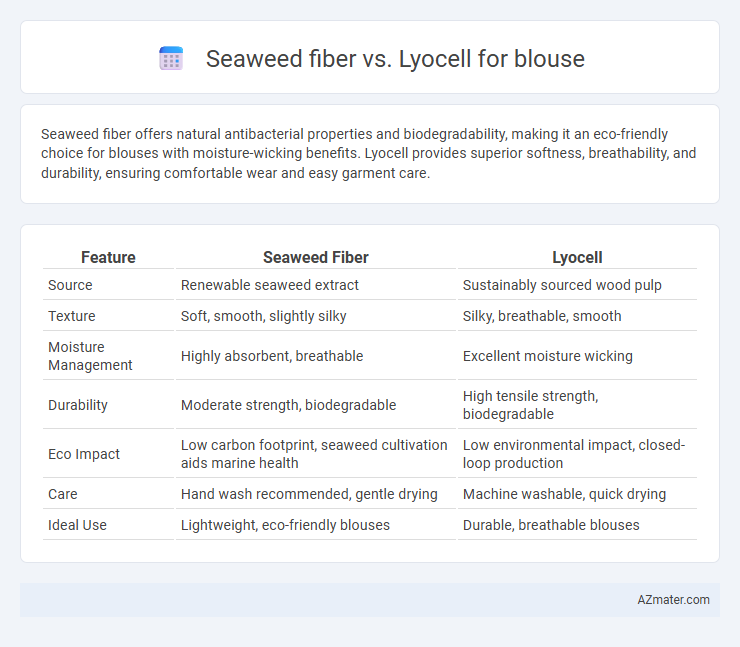Seaweed fiber offers natural antibacterial properties and biodegradability, making it an eco-friendly choice for blouses with moisture-wicking benefits. Lyocell provides superior softness, breathability, and durability, ensuring comfortable wear and easy garment care.
Table of Comparison
| Feature | Seaweed Fiber | Lyocell |
|---|---|---|
| Source | Renewable seaweed extract | Sustainably sourced wood pulp |
| Texture | Soft, smooth, slightly silky | Silky, breathable, smooth |
| Moisture Management | Highly absorbent, breathable | Excellent moisture wicking |
| Durability | Moderate strength, biodegradable | High tensile strength, biodegradable |
| Eco Impact | Low carbon footprint, seaweed cultivation aids marine health | Low environmental impact, closed-loop production |
| Care | Hand wash recommended, gentle drying | Machine washable, quick drying |
| Ideal Use | Lightweight, eco-friendly blouses | Durable, breathable blouses |
Introduction to Sustainable Fibers in Fashion
Seaweed fiber and Lyocell represent two innovative sustainable fibers gaining prominence in fashion, particularly for blouse production. Seaweed fiber is derived from seaweed biomass, offering biodegradability and natural moisture absorption, while Lyocell is manufactured from sustainably sourced wood pulp through a closed-loop process, known for its softness and breathability. Both fibers minimize environmental impact through renewable resources and reduced chemical use, aligning with growing consumer demand for eco-friendly textiles.
What is Seaweed Fiber?
Seaweed fiber is an eco-friendly textile material derived from natural seaweed algae, known for its biodegradability and moisture-wicking properties, making it a sustainable alternative for blouse fabric. It offers a silky texture similar to lyocell, which is a wood pulp-based fabric produced through a closed-loop process emphasizing environmental responsibility. Compared to lyocell, seaweed fiber provides unique skin-soothing benefits due to its mineral content while maintaining breathability and softness ideal for lightweight blouses.
What is Lyocell Fiber?
Lyocell fiber is a sustainable, biodegradable fabric made from wood pulp, primarily eucalyptus trees, processed through a closed-loop system that minimizes environmental impact. Known for its softness, breathability, and moisture-wicking properties, Lyocell is often favored for blouses due to its smooth texture and durability. Compared to seaweed fiber, Lyocell offers enhanced strength and a silk-like feel, making it a popular choice for eco-conscious fashion with comfortable wearability.
Production Process: Seaweed Fiber vs Lyocell
Seaweed fiber is produced by extracting cellulose from seaweed through an environmentally friendly process that involves enzymatic treatment and minimal chemicals, making it biodegradable and sustainable. Lyocell is manufactured from wood pulp using a closed-loop solvent spinning process that recycles almost all chemicals and water, reducing environmental impact. Both fibers prioritize eco-conscious production, but seaweed fiber offers an innovative marine-based source, while Lyocell relies on sustainable forestry practices.
Environmental Impact Comparison
Seaweed fiber offers significant environmental benefits over lyocell, utilizing renewable marine resources that require minimal water and no harmful chemicals during processing. Lyocell production involves wood pulp and a closed-loop solvent system, which reduces environmental harm compared to traditional fibers but still depends on forestry and intensive water use. Seaweed fiber's biodegradability and lower carbon footprint make it a more sustainable choice for eco-friendly blouse manufacturing.
Comfort and Wearability of Seaweed vs Lyocell Blouses
Seaweed fiber blouses offer natural breathability and moisture-wicking properties, enhancing comfort in warm climates by keeping the skin dry and cool. Lyocell blouses provide a soft, smooth texture with excellent drape and durability, making them ideal for everyday wear with minimal irritation. Both fibers are eco-friendly, but seaweed fiber's mineral content can promote skin health, while Lyocell's closed-loop production ensures a sustainable, hypoallergenic fabric.
Moisture Management and Breathability
Seaweed fiber offers excellent moisture management by naturally absorbing and releasing moisture, keeping the skin dry and comfortable during extended wear. Lyocell, derived from eucalyptus, also provides superior breathability with its smooth fibers that enhance air circulation and reduce heat retention. Both materials excel in moisture control, but seaweed fiber's unique ability to regulate humidity makes it particularly advantageous for blouses worn in warm and humid conditions.
Durability and Care Instructions
Seaweed fiber offers moderate durability but requires gentle hand washing and air drying to maintain its integrity, while Lyocell stands out with high durability and is machine washable on a gentle cycle, making it easier to care for in everyday use. Both fibers provide softness suitable for blouses, but Lyocell's resistance to wear and shrinkage ensures longer garment life under regular laundering. Choosing Lyocell over seaweed fiber can reduce the risk of fabric damage and simplify care routines for durable, low-maintenance blouses.
Price and Market Availability
Seaweed fiber blouses are emerging in the sustainable fashion market but remain limited in availability and are typically priced higher due to niche production and eco-friendly processing methods. Lyocell blouses, widely available and produced at scale, offer a more cost-effective option with competitive pricing driven by established supply chains. Consumers seeking affordable yet sustainable fabrics are more likely to find lyocell readily accessible across major fashion retailers.
Which Fiber is Better for Blouses?
Seaweed fiber offers natural antibacterial properties and excellent moisture absorption, making it ideal for breathable and eco-friendly blouses. Lyocell, derived from sustainable wood pulp, provides superior strength, softness, and wrinkle resistance, enhancing blouse durability and comfort. For blouses requiring a balance of sustainability, comfort, and longevity, Lyocell tends to be the better choice, while seaweed fiber suits those prioritizing natural texture and eco-conscious benefits.

Infographic: Seaweed fiber vs Lyocell for Blouse
 azmater.com
azmater.com